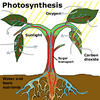Photosynthesis, nutrition and respiration
All living things require energy. The energy source for all life on Earth is ultimately the Sun. Without the ability of plant pigments to capture the Sun's light energy, life as we know it on Earth would not exist.
Photosynthesis
Photosynthesis is the process by which plant cells make sugar (glucose)
using sunlight energy, water and carbon dioxide. The sugar is then transported
to all parts of the plant and used as an energy source for growth and
survival, or stored as starch for later use. Animals eating these plants
obtain this ready-made energy source.
A green pigment, chlorophyll, is stored within small organelles called chloroplasts within many plant cells. It is mainly found in leaves and stems, thereby giving these parts a green appearance.
 Chlorophyll, an iron-based molecule, can absorb light and become
energised, and then pass on this energy to combine the water and carbon
dioxide molecules to form sugar.
Chlorophyll, an iron-based molecule, can absorb light and become
energised, and then pass on this energy to combine the water and carbon
dioxide molecules to form sugar.
Water travels up from the soil through roots and xylem tubes (see Plant
systems A: Transport and support) and the carbon dioxide moves into
the leaf cells through small holes in the leaf surface called stomata.
Whole plant showing water passing from soil up roots and xylem, and carbon
dioxide entering leaves.
The chemical equation for photosynthesis is:
|
light
|
||
| 6 CO2 + 12H2 O | C6 H12 O6 + 6 H2 O + 6 O2 |
 Six molecules of carbon dioxide combine with twelve molecules of
water in the presence of light to form one molecule of glucose sugar,
six molecules of water and six molecules of oxygen.
Six molecules of carbon dioxide combine with twelve molecules of
water in the presence of light to form one molecule of glucose sugar,
six molecules of water and six molecules of oxygen.
Oxygen is a by-product of this process. Any excess oxygen not required by the plant is released into the atmosphere, and is therefore available for animals to use.
Nutrition
Further uptake of other minerals from the soil provides the necessary
elements required by the plant to make proteins and all other substances
for growth and functioning of the plant. These too are taken in by animals
when they eat the plant as food.
Respiration
Since all living things need energy, animals are ultimately dependent
on plants for food.
In the mitochondria (see Animal
cells) of all plant and animal cells, the energy trapped in the sugar
molecule is released during the process of cellular respiration. The sugar
combines with oxygen to form carbon dioxide (CO2) and water
as by-products, and the energy is given off.
| 6 O2 + C6 H12O6 | 6CO2 + H2O + ENERGY |
Six molecules of oxygen combine with one molecule of sugar to form ENERGY, plus six molecules of carbon dioxide and six molecules of water.
 Note that carbon dioxide is a by-product of respiration, which is
then available for plants to use in photosynthesis. In other words, plants
and animals are interdependent and the balance of oxygen and carbon dioxide
in nature is vitally important.
Note that carbon dioxide is a by-product of respiration, which is
then available for plants to use in photosynthesis. In other words, plants
and animals are interdependent and the balance of oxygen and carbon dioxide
in nature is vitally important.
The energy released in respiration is available for movement, growth, and all the life functions ("metabolism").
A healthy plant in good growing conditions produces more sugar through photosynthesis than it uses up in cellular respiration. It also produces more oxygen than it needs, so a supply of both food and oxygen for animals is maintained. The logging of vast areas of rainforest can greatly upset this balance in nature because photosynthesis is reduced.
| Copyright owned by the State of Victoria (Department of Education and Early Childhood Development). Used with Permission. |